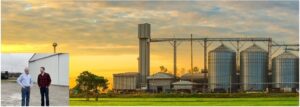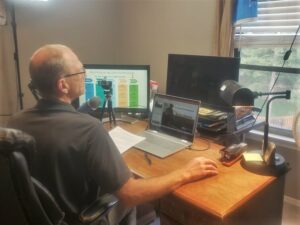And What you need to do to survive, thrive and prosper through them!
Megatrends can be defined as those trends that are universal to everyone in the category and viewed as permanent. In other words, it’s not a 3-5-year trend. A megatrend is something that will most likely not reverse.
A few words of caution about this article in general. Often, when someone writes an article like this, they seem foreboding or ominous or negative. They make it seem that farming is coming to an end. I feel the exact opposite. Growing up in agribusiness, I learned that volatility is opportunity. There is certainly enough negativity going around the Ag industry right now that we don’t need to add to it. Think about this for a minute. There are more people eating more food every day. Demand is not going away, but how we supply it will change. We just need to be smart enough to recognize the trends and change with them – before we are forced to. Again, I think there is a high demand for food as well as high demand for capable employees in agribusiness. Ask any agribusiness about their greatest challenges. Hiring and retaining top talent will be in the top 2 on that list.
#1: Tighter End User Economics
Trend: Tighter margins for the end user will eventually backtrack up through the vendor channel that sells to them. Crop producers are very near or below breakeven. Several livestock markets are in the same situation. Yet, there are plenty of producers that have equity built up and own their land/equipment, which allows them to be profitable. Tough times also allows for those in better financial positions to grow by merger & acquisition.
What should an Ag Sales Professional do? Get a better business sense.
- Know your numbers: know your total ROI to the company. Sure, it’s important to know how many units you sell. However, somewhere within your organization, someone is calculating the ROI of the sales team. If you are not given actual margin dollars, ask. If that’s not available, ask for a rough margin estimate on your territory by unit. Once you know that, subtract out your cost. You cost roughly 1.25 X your pay + expenses. For example, you make $50,000 plus another $10,000 in expenses. Your total cost is around $75,000 (60,000 X 1.25). Now compare that to your territory gross margin.
- Know your customer’s numbers: Understand the economics of whether or not a producer can afford your $200 bag of seed or your $300 bag of seed. If their ground and farming practices won’t net a higher ROI on the $300 bag of seed, you shouldn’t sell it to them. Just because their yield goes up, doesn’t mean they make more money. Same with a more fortified dairy feed ration or hog feed. Know their economics and do what’s right for them. Of course, the opposite of that situation is true as well. A cheaper up-front cost ($200/bag of seed) does not mean a higher ROI at harvest. That’s the tough part of your job – Getting that point across to your customer.
- Lastly, pick your head up and look down range. What are customers in your market doing as a reaction to their economics? More cash rent, more ag lending, leaning more on vendor financing, selling their livestock and going into contract grower arrangements? What will this trend do for your business and how do you get in front of it? What products or services are they moving to? How can you dip your toe in the water and sell those products or services? What strengths do you and your company have in those areas that you can leverage?
#2: Fewer Local Offices & Support Staff
Trend: Your local office isn’t so local anymore. With the web, cloud storage, VOIP phones, and more customer accessible accounts, companies are deciding they don’t need local offices. Is it right or wrong? Does it save or cost money? That’s a blog “for a whole ‘nother day!” You just need to figure out how to adapt and prosper as these changes occur.
What should an Ag Sales Professional do? Learn & Embrace it
- You can go to the bar after the sales meeting and complain all you want, but that will get you absolutely nowhere. Trust me, I tried it for years and got nowhere with it. Come Monday morning, you are still going to have to call someone 300 miles away to process that credit memo for your customer.
- Jump in with both feet on the new program or newly assigned people. In all the years of mergers, consolidation and technology changes, I have found very few that didn’t have some upside. Yes, there was the inconvenience of doing it different than the old way. But, most of the time, there was a positive outcome. Those salespeople that did the best were those that just jumped in and didn’t dwell on it. So, go into the new program and “break the toy” as I call it. Hit all the keys, press all the buttons on the new I-pad. You won’t break it. Call the new person 300 miles away and learn about them. They have a family and work hard just like the local person does. Instead of calling up angry as every other salesperson in your company is doing, show some understanding and talk to them.
- Customer Acceptance: This can be the toughest part of the change. You can change your attitude towards the change immediately. But it’s tougher to change your customer’s opinion of the change. However, guess who they are looking to for a clue as to how to react? That’s right, you! So, even though it’s tempting, commiserating with your customer about it will not help. If you truly can’t say something positive, then persist through it in neutral. Show them how to navigate the new program. “Yeah, it’s different and I was comfortable with the old way as well. Here’s how we get this done, now.”
#3: Fewer Salespeople
Trend: The total cost of outfitting a salesperson with a vehicle and all the electronics is increasing. Add in training & development and the cost of putting a salesperson in front of a customer goes higher. Now, factor in the cost of a salesperson who calls on either the wrong customers or customers that don’t value a qualified salesperson calling on them. And, we didn’t even count the first couple of years when a salesperson is getting up to speed on selling and the technical side of the business. Seems strange for a sales guy to say all that. However, that thought is going on whether or not I say it or you know it. Companies are looking at their sales team structure and challenging their Go-To-Market strategy.
Ag is very geographic with remote sales teams. However, does it make sense to have a salesperson who is naturally wired to call on 100 cow dairies twisting in knots trying to call on 1000 cow dairies just because they are nearby? Probably not. Doing so decreases their effectiveness at selling both. Customer segmentation and sales team alignment with those segments is an option.
Another aspect is the old incremental units sold to high volume low margin customers. These are large accounts that require we sell at a lower margin. Their volume helps to reduce cost per unit, hence the term incremental units. Does it make sense to field a sales force to sell to large operations, who don’t value the technical expertise of your salespeople? They simply want the price, the product and the logistics to fit their operation. I realize these accounts give you a large amount of unit and gross dollar sales, but at what net margin?
What should an Ag Sales Professional do? Increase your efficiency & effectiveness!
- Find out if your company has done any customer segmentation work. If not, you need to do it within your own territory.
- Figure out which segment you are good at. Large, small, direct to the farm, through a dealer network, through a distributor? Which do you like and which are you good at?
- Once you figure that out, expand into that space with gusto! Be the greatest there is in your company and in your market at selling the 500-acre customer. If a 2000-acre customer comes along and wants to spend money with you, great. But stay focused on your target market. One important thing I forgot to say here. The market you decide to go after needs to be in line with what your company can service and it has to be big enough to sustain you and the assets that make product for them.
- Lastly and maybe most important. For those customers you are calling on, figure out why they value you coming to their farm and calling on them. There was a time when the salesperson was the sole source of product knowledge and ordering. Cell phones, the internet and hundreds of local meetings later, most customers can do their own research and put in their own orders. How do you expand on that information and add more value? How do you help that customer get the most value from their operation by matching your company’s resources up to them?
Join me next time as we look at the last two Megatrends going on in the world of the Ag Sales Professional.

For more information on Ag sales training, coaching or business development, contact
Greg Martinelli at Ag Sales Professionals, LLC
at (608) 751-6971.
Email is Greg@GregMartinelli.net
Web site is www.GregMartinelli.net



